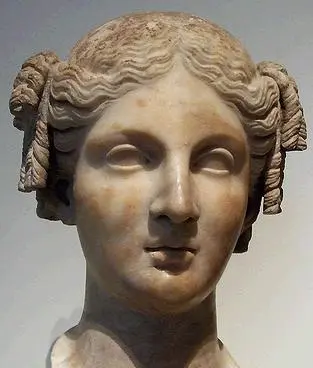
Roman marble head of Venus
1st-2nd century
(source: https://www.pinterest.com/pin/546061523544594144/)

1st C. AD Roman bust
(source: https://janeaustensworld.wordpress.com/2009/11/07/regency-hairstyles-and-their-accessories/)

1st C. AD Roman bust
(source: https://janeaustensworld.wordpress.com/2009/11/07/regency-hairstyles-and-their-accessories/)

Portrait of a British cavalry officer’s wife
Oil on canvas
Oil on canvas
1826
Artist: Giuseppe Bezzuoli
(source: https://www.pinterest.com/pin/546061523543967911/)

Amalie von Schintling
Oil on canvas
1831
Artist: Joseph Karl Stieler
(source: https://www.pinterest.com/pin/546061523542256100/)

Amalie von Schintling
Oil on canvas
1831
Artist: Joseph Karl Stieler
(source: https://www.pinterest.com/pin/546061523542256100/)

Portrait of a Lady
miniature on ivory
1832
Artist: Carl Von Saar
(source: https://www.pinterest.com/pin/546061523543967884/)
As fashion changed, and skirts and hoops got bigger, so did the hairstyles. They stopped wearing their hair so tight. The middle parting remained, the hair was straight and smooth at the roots, with curls at the ends. By the 1850s they greased their roots to make them even smoother, frizzed curls on the sides and the rest of the hair in a topknot. To grease the hair they would use home made pomade, Macassar oil or perfumed grease. They still had to wear hats in public but covering only the back of their heads. Twists and braids were added, as well as accessories such ribbons, lace and jeweled combs. Austrian Empress Elizabeth started the trend of adding flowers.
Three young women
photograph
1845
(source: https://www.pinterest.com/pin/546061523543555440/)

1850s hairstyles
(source: https://www.pinterest.com/pin/546061523543457302/)
Early Victorian hairstyle practice
For my early Victorian hairstyle I decided to make a topknot out of curls and frame the face witf eight curls.
First I created a middle parting and sectioned the fringe. Then I curled the rest of the hair and pinned it into a high topknot. Doll's hair is very dry and it was quite hard to style the fringe, and it wouldn't look good if I didn't pin them all. So I made four even sections on each side and curled it with medium size tongs and pinned them around the forehead, down to the ears.
Sectioning
Sectioning hair before curling
Hair after curling
Curls pinned into a topknot
Curling the fringe
Pinned fringe
Final look
http://www.fashionencyclopedia.com/fashion_costume_culture/European-Culture-19th-Century/Nineteenth-Century-Headwear.html
http://merryfarmer.net/2013/04/the-beauty-and-evolution-of-19th-century-hairstyles/
http://thehistoryofthehairsworld.com/hair_19th_century.html
reference found on feb 1st/5th/11th 2015







Nema komentara:
Objavi komentar